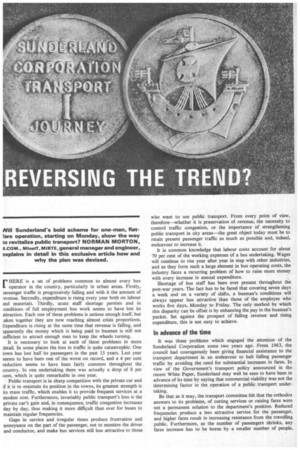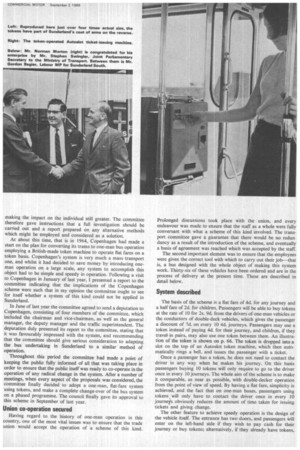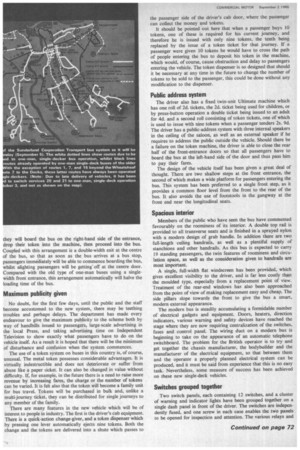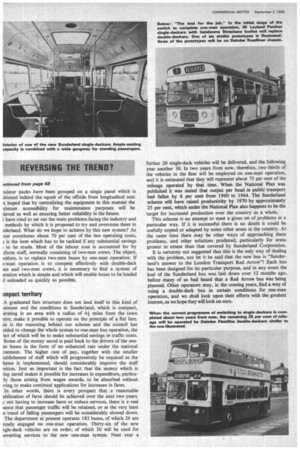F HERE is a set of problems common to almost every
Page 68

Page 69

Page 70

Page 74

If you've noticed an error in this article please click here to report it so we can fix it.
bus operator in the country, particularly in urban areas. Firstly, )assenger traffic is progressively falling and with it the amount of -evenue. Secondly, expenditure is rising every year both on labour and materials. Thirdly, acute staff shortage persists and in ;onditions of full employment bus work seems to have lost its attraction. Each one of these problems is serious enough itself, but :aken together they are now reaching almost crisis proportions. Expenditure is rising at the same time that revenue is falling, and apparently -the money which is being paid to busmen is still not sufficient to attract enough men to keep the wheels turning.
It is necessary to look at each of these problems in more detail. In some places the loss in traffic is quite catastrophic. One town has lost half its passengers in the past 15 years. Last year seems to have been one of the worst on record, and a 4 per cent reduction seems to have been fairly common throughout the _ country. In one undertaking there was actually a drop of 8 per cent, which is quite remarkable in one year.
Public transport is in sharp competition with the private car and if it is to maintain its position in the towns, its greatest strength is its mass traffic, which enables it to provide frequent services at a modest cost. Furthermore, invariably public transport's loss is the private car's gain and, in consequence, traffic congestion increases day by day, thus making it more difficult than ever for buses to maintain regular frequencies.
Gaps in service and irregular times produce frustration and annoyance on the part of the passenger, not to mention the driver and conductor, and make bus services still less attractive to those who want to use public transport. From every point of view, therefore—‘whether it is preservation of revenue, the necessity to control traffic congestion, or the importance of strengthening public transport in city areas—the great object today must be to retain present passenger traffic as much as possible and, indeed, endeavour to increase it.
It is common knowledge that labour costs account for about 70 per cent of the working expenses of a bus undertaking. Wages will continue to rise year after year in step with other industries, and as they form such a large element in bus operating costs, the industry faces a recurring problem of how to raise more money with every increase in annual expenditure.
Shortage of bus staff has been ever present throughout the post-war years. The fact has to be faced that covering seven days a week and on a variety of shifts, a busman's conditions will always appear less attractive than those of the employee who works five days, Monday to Friday. The only method by which this disparity can be offset is by enhancing the pay in the busman's packet. Set against the prospect of falling revenue and rising expenditure, this is not easy to achieve.
In advance of the time It was these problems which engaged the attention of the Sunderland Corporation some two years ago. From 1963, the council had courageously been giving financial assistance to the transport department in an endeavour to halt falling passenger traffic by avoiding the need for substantial increases in fares. In view of the Government's transport policy announced in the recent White Paper, Sunderland may well be seen to have been in advance of its time by saying that commercial viability was not the determining factor in the operation of a public transport undertaking.
Be that as it may, the transport committee felt that the orthodox answers to its problems, of cutting services or raising fares were not a permanent solution to the department's position. Reduced frequencies produce a less attractive service for the passenger, and higher fares result in increasing resistance from the travelling public. Furthermore, as the number of passengers shrinks, any fares increase has to be borne by a smaller number of people, making the impact on the individual still greater. The committee therefore gave instructions that a full investigation should be carried out and a report prepared on any alternative methods which might be employed and considered as a solution.
At about this time, that is in 1964, Copenhagen had made a start on the plan for converting its trams to one-man bus operation employing a British-made token machine to operate flat fares on a token basis. Copenhagen's system is very much a mass transport one, and whilst it had decided to save money by introducing oneman operation on a large scale, any system to accomplish this object had to be simple and speedy in operation. Following a visit to Copenhagen in January of last year, I presented a report to the committee indicating that the implications of the Copenhagen scheme were such that in my opinion the committee ought to see for itself whether a system of this kind could not be applied in Sunderland.
In June of last year the committee agreed to send a deputation to Copenhagen, consisting of four members of the committee, which included the chairman and vice-chairman, as well as the general manager, the deputy manager and the traffic superintendent. The deputation duly presented its report to the committee, stating that it was favourably impressed with the system, and recommending that the committee should give serious consideration to adapting the bus undertaking in Sunderland to a similar method of operation.
Throughout this period the committee had made a point of keeping the public fully informed of all that was taking place in order to ensure that the public itself was ready to co-operate in the operation of any radical change in the system. After a number of meetings, when every aspect of the proposals was considered, the committee finally decided to adopt a one-man, flat-fare system using tokens, and make a complete change-over of the bus system on a phased programme. The council finally gave its approval to this scheme in September of last year.
Union co-operation secured Having regard to the history of one-man operation in this country, one of the most vital issues was to ensure that the trade union would accept the operation of a scheme of this kind.
Prolonged discussions took place with the union, and every endeavour was made to ensure that the staff as a whole were fully conversant with what a scheme of this kind involved. The transport committee gave a guarantee that there would be no redundancy as a result of the introduction of the scheme, and eventually a basis of agreement was reached which was accepted by the staff.
The second important element was to ensure that the employees were given the correct tool with which to carry out their job—that is, a bus designed with the whole object of making this system work. Thirty-six of these vehicles have been ordered and are in the process of delivery at the present time. These are described in detail below.
System described The basis of the scheme is a flat fare of 4d. for any journey and a half fare of 2d. for children. Passengers will be able to buy tokens at the rate of 10 for 2s. 9d. from the drivers of one-man vehicles or the conductors of double-deck vehicles, which gives the passenger a discount of 7d. on every 10 4d. journeys. Passengers may use a token instead of paying 4d. for their journey, and children, if they
• travel, in pairs, may also use one token between them. An illustration of the token is shown on p. 66. The token is dropped into a slot on the top of an Autoslot token machine, which then automatically rings a bell, and issues the passenger with a ticket.
Once a passenger has a token, he does not need to contact the driver in any way when he makes his journey. On this basis passengers buying 10 tokens will only require to go to the driver once in every 10 journeys. The whole aim of the scheme is to make it comparable, as near as possible, with double-decker operation from the point of view of speed. By having a flat fare, simplicity is achieved, and the fact that on one-man buses, passengers using tokens, will only have to contact the driver once in every 10 journeys obviously reduces the amount of time taken for issuing tickets and giving change.
The other feature to achieve speedy operation is the design of the vehicle itself. The entrance has two doors, and passengers will enter on the left-hand side if they wish to pay cash for their journey or buy tokens; alternatively, if they already have tokens, they will board the bus on the right-hand side of the entrance, drop their token into the machine, then proceed into the bus. Coupled with this arrangement is a double-width exit at the centre of the bus, so that as soon as the bus arrives at a bus stop, passengers immediately will be able to commence boarding the bus, whilst alighting passengers will be getting offat the centre door. Compared with the old type of one-man buses using a singlewidth front entrance, this arrangement automatically will halve the loading time of the bus.
Maximum publicity given
No doubt, for the first few days, until the public and the staff become accustomed to the new system, there may be teething troubles and perhaps delays. The department has made every endeavour to give the maximum publicity to the scheme both by way of handbills issued to passengers, large-scale advertising in the local Press, and taking advertising time on Independent Television to show exactly what passengers have to do on the vehicle itself. As a result it is hoped that there will be the minimum of disturbance and confusion when the system commences.
The use of a token system on buses in this country is, of course, unusual. The metal token possesses considerable advantages. It is virtually indestructible and does not deteriorate or suffer from abuse like a paper ticket. It can also be changed in value without difficulty. If, for example, in the future there is a need to raise more revenue by increasing fares, the charge or the number of tokens can be varied. It is felt also that the token will become a family unit for bus travel. Tokens will be purchased in bulk and, unlike a multi-journey ticket, they can be distributed for single journeys to any member of the family.
There are many features in the new vehicle which will be of interest to people in industry. The first is the driver's cab equipment. There is a quick-action change-giver, and a token dispenser which by pressing one lever automatically ejects nine tokens. Both the change and the tokens are delivered into a shute which passes to
the passenger side of the driver's cab door, where the passenger can collect the money and tokens.
It should be pointed out here that when a passenger buys 10 tokens, one of these is required for his current journey, and therefore he is issued with only nine tokens, the tenth being replaced by the issue of a token ticket for that journey. If a passenger were given 10 tokens he would have to cross the path of people entering the bus to deposit his token in the machine, which would, of course, cause obstruction and delay to passengers entering the vehicle. The token dispenser is so designed that should it be necessary at any time in the future to change the number of tokens to be sold to the passenger, this could be done without any modification to the dispenser.
Public address system
The driver also has a fixed twin-unit Ultimate machine which has one roll of 2d. tickets, the 2d. ticket being used for children, or by press-button operation a double ticket being issued to an adult for 4d. and a second roll consisting of token tickets, one of which is used to issue with nine tokens when a passenger tenders 2s. 9d. The driver has a public-address system with three internal speakers in the ceiling of the saloon, as well as an external speaker if he requires to address the public outside the vehicle. Should there be a failure on the token machine, the driver is able to close the rear half of the front-entrance doors so that all passengers have to board the bus at the left-hand side of the door and thus pass him to pay their fares.
The design of the vehicle itself has been given a great deal of thought. There are two shallow steps at the front entrance, the second of which makes a wide platform for passengers entering the bus. This system has been preferred to a single front step, as it provides a common floor level from the front to the rear of the bus. It also avoids the use of footstools in the gangway at the front end near the longitudinal seats.
Spacious interior
Members of the public who have seen the bus have commented favourably on the roominess of its interior. A double top rail is provided to all transverse seats and is finished in a sprayed nylon with a modern design of grab handle. In addition there are two full-length ceiling handrails, as well as a plentiful supply of stanchions and other handrails. As this bus is expected to carry 19 standing passengers, the twin features of roominess and circulation space, as well as the consideration given to handrails are most important.
A single, full-width flat windscreen has been provided, which gives excellent visibility to the driver, and is far less costly than the moulded type, especially from a replacement point of view. Treatment of the rear-end windows has also been approached from the point of view of making replacement easy and cheap. The side pillars slope towards the front to give the bus a smart, modern external appearance.
The modern bus is steadily accumulating a formidable number of electrical gadgets and equipment. Doors, heaters, direction indicators, various warning and safety devices have reached the stage where they are now requiring centralization of the switches, fuses and control panel. The wiring duct on a modern bus is beginning to take on the appearance of an automatic telephone switchboard. The problem for the British operator is to try and get together the chassis manufacturer, the bodybuilder and the manufacturer of the electrical equipment, so that between them and the operator a properly planned electrical system can be produced, and it must be said from experience that this is no easy task. Nevertheless, some measure of success has been achieved on these new single-deck vehicles.
Switches grouped together
Two switch panels, each containing 12 switches, and a cluster of warning and indicator lights have been grouped together on a single dash panel in front of the driver. The switches are independently fused, and one screw in each case enables the two panels to be opened for inspection and attention. The various relays and asistor packs have been grouped on a single panel which is &lotted behind the squab of the offside front longitudinal seat. s hoped that by centralizing the equipment in this manner the ximum accessibility for maintenance purposes will be fieved as well as ensuring better reliability in the future.
[ have tried to set out the main problems facing the industry and methods by which it is proposed to try and overcome them in aderland. What do we hope to achieve by this new system? As our constitutes about 70 per cent of the bus operating costs, 3 is the item which has to be tackled if any substantial savings : to be made. Most of the labour cost is accounted for by tform staff, normally consisting of two-men crews. The object, refore, is to replace two-men buses by one-man operation. If e-man operation is to compete effectively with double-deck ses and two-men crews, it is necessary to find a system of eration which is simple and which will enable buses to be loaded d unloaded as quickly as possible.
impact territory
A graduated fare structure does not lend itself to this kind of :atment and the conditions in Sunderland, which is compact, erating in an area with a radius of 41 miles from the town ntre, make it possible to operate on the principle of a flat fare. Lis is the reasoning behind our scheme and the council has cided to change the whole system to one-man bus operation, the 'ect of which will be to make substantial savings in traffic costs. Some of the money saved is paid back to the drivers of the onean buses in the form of an enhanced rate under the national reement. The higher rate of pay, together with the smaller tablishment of staff which will progressively be required as the heme is implemented, should considerably improve the staff isition. Just as important is the fact that the money which is ing saved makes it possible for increases in expenditure, particurly those arising from wages awards, to be absorbed without tying to make continual applications for increases in fares.
In other words, there is every prospect that a reasonable abilization of fares should be achieved over the next two years. yr not having to increase fares or reduce services, there is a real Lance that passenger traffic will be retained, or at the very least e trend of falling passengers will be considerably slowed down. The department at present operates 183 buses, of which 26 are ready engaged on one-man operation. Thirty-six of the new ogle-deck vehicles are on order, of which 30 will be used for )nverting services to the new one-man system. Next year a further 20 single-deck vehicles will be delivered, and the following year another 30. In two years from now, therefore, two thirds of the vehicles in the fleet will be employed on one-man operation, and it is estimated that they will represent about 75 per cent of the mileage operated by that time. When the National Plan was published it was stated that output per head in public transport had fallen by 6 per cent from 1960 to 1964. The Sunderland scheme will have raised productivity by 1970 by approximately 25 per cent, which under the National Plan also happens to be the target for increased production over the country as a whole.
This scheme is an attempt to meet a given set of problems in a particular way. If it is successful there is no doubt it could be usefully copied or adapted by some other areas in the country. At the same time there may be other ways of approaching these problems, and other solutions produced, particularly for areas greater in extent than that covered by Sunderland Corporation.
It is certainly not suggested that this is the only way of dealing with the problem, nor let it be said that the new bus is "Sunderland's answer to the London Transport Red Arrow"! Each bus has been designed for its particular purpose, and in any event the keel of the Sunderland bus was laid down over 12 months ago, before many of us had heard that a Red Arrow bus was being planned. Other operators may, in the coming years, find a way of using a double-deck bus in certain conditions for one-man operation, and we ,shall look upon their efforts with the greatest interest, as we hope they will look on ours.
































































































































